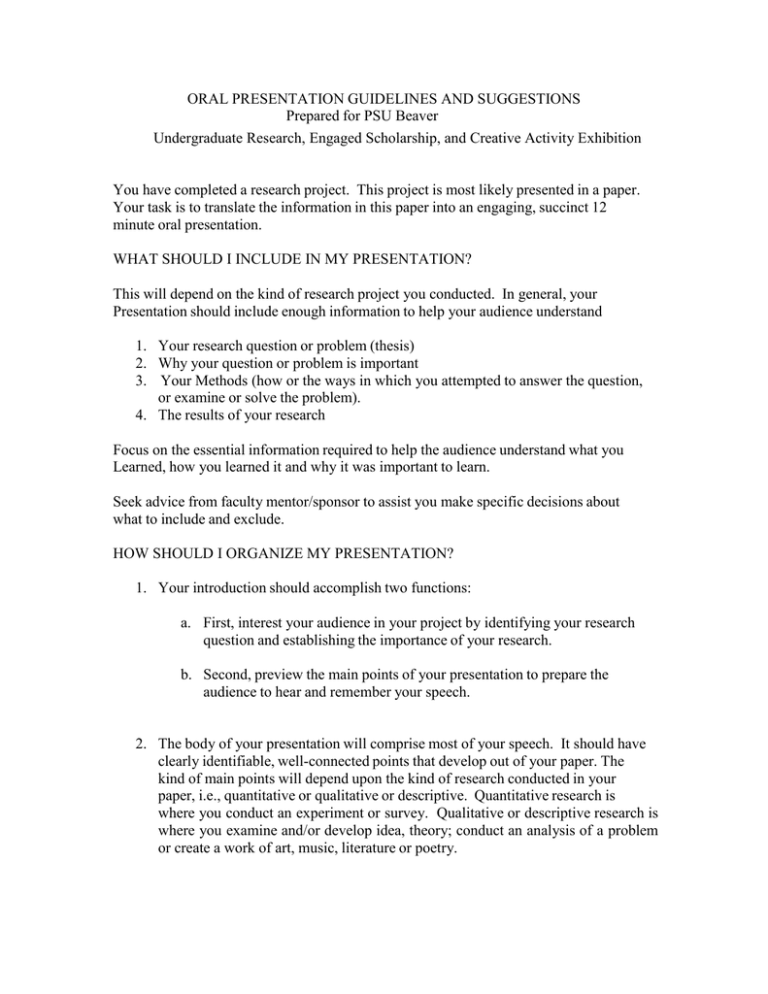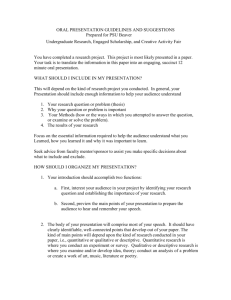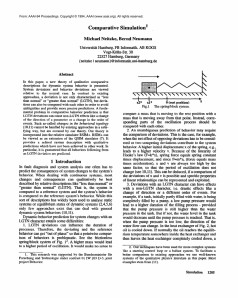ORAL PRESENTATION GUIDELINES AND SUGGESTIONS Prepared for PSU Beaver
advertisement

ORAL PRESENTATION GUIDELINES AND SUGGESTIONS Prepared for PSU Beaver Undergraduate Research, Engaged Scholarship, and Creative Activity Exhibition You have completed a research project. This project is most likely presented in a paper. Your task is to translate the information in this paper into an engaging, succinct 12 minute oral presentation. WHAT SHOULD I INCLUDE IN MY PRESENTATION? This will depend on the kind of research project you conducted. In general, your Presentation should include enough information to help your audience understand 1. Your research question or problem (thesis) 2. Why your question or problem is important 3. Your Methods (how or the ways in which you attempted to answer the question, or examine or solve the problem). 4. The results of your research Focus on the essential information required to help the audience understand what you Learned, how you learned it and why it was important to learn. Seek advice from faculty mentor/sponsor to assist you make specific decisions about what to include and exclude. HOW SHOULD I ORGANIZE MY PRESENTATION? 1. Your introduction should accomplish two functions: a. First, interest your audience in your project by identifying your research question and establishing the importance of your research. b. Second, preview the main points of your presentation to prepare the audience to hear and remember your speech. 2. The body of your presentation will comprise most of your speech. It should have clearly identifiable, well-connected points that develop out of your paper. The kind of main points will depend upon the kind of research conducted in your paper, i.e., quantitative or qualitative or descriptive. Quantitative research is where you conduct an experiment or survey. Qualitative or descriptive research is where you examine and/or develop idea, theory; conduct an analysis of a problem or create a work of art, music, literature or poetry. 3. CONCLUSION: Should also accomplish two functions: a. Summarize your main points. b. End with a powerful line that reinforces the importance of your Research. 4. USE TRANSITIONS: In addition to basic structure (introduction, body and conclusion, you can improve the organization of your presentation by using transitions from one section to the next and from one main point to the next. Transitions provide clear guides to your audience as they listen to you. HOW SHOULD I DELIVER MY PRESENTION? Keep in mind that your research is what matters most. While effective delivery can enhance a strong research project, good delivery cannot improve weak research! Strive to deliver your presentation extemporaneously. That means do not read from your paper and also do not memorize your presentation. Instead, work at internalizing it by planning, preparing and practicing. Know your material so well that you can speak with authority about it without having to read sentence or memorize specific words. You are welcome to use note cards to help guide you during your presentation by citing a few key words and phrases rather than full sentences. DELIVERY TIPS; Practice your presentation several times (at least 10 times, even 20) Practice it out loud. Practice it in front of your faculty mentor/sponsor. Practice it in front of a mirror. Practice in front of friends, family members, your pets, anyone who will listen. If you have visual aids, practice your speech using them. Time your speech when you practice if to ensure it fits the 12 minute time limit. Lastly, what matters most is your research, what you have learned, how you learned it, why it was important to learn. The emphasis is on your research – not on you.





